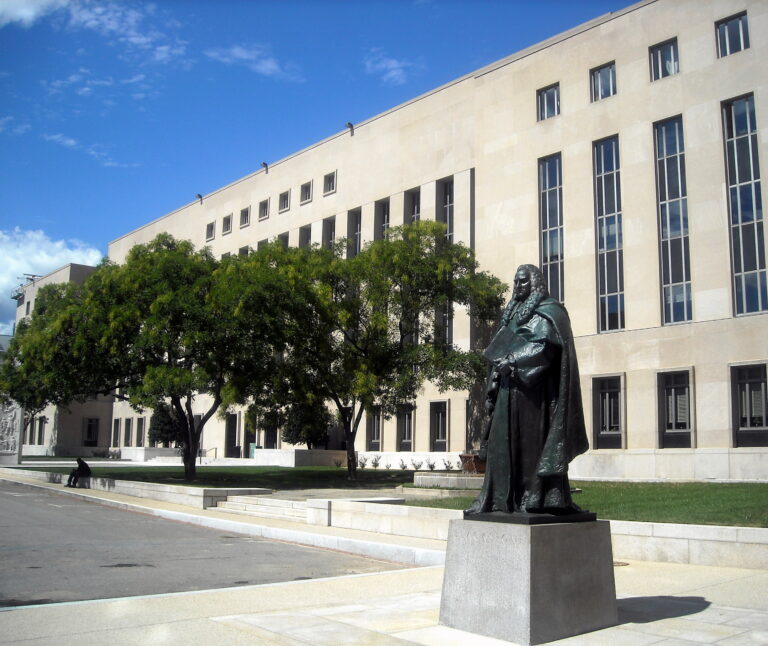
Benjamin Sachs is the Kestnbaum Professor of Labor and Industry at Harvard Law School and a leading expert in the field of labor law and labor relations. He is also faculty director of the Center for Labor and a Just Economy. Professor Sachs teaches courses in labor law, employment law, and law and social change, and his writing focuses on union organizing and unions in American politics. Prior to joining the Harvard faculty in 2008, Professor Sachs was the Joseph Goldstein Fellow at Yale Law School. From 2002-2006, he served as Assistant General Counsel of the Service Employees International Union (SEIU) in Washington, D.C. Professor Sachs graduated from Yale Law School in 1998, and served as a judicial law clerk to the Honorable Stephen Reinhardt of the United States Court of Appeals for the Ninth Circuit. His writing has appeared in the Harvard Law Review, the Yale Law Journal, the Columbia Law Review, the New York Times and elsewhere. Professor Sachs received the Yale Law School teaching award in 2007 and in 2013 received the Sacks-Freund Award for Teaching Excellence at Harvard Law School. He can be reached at [email protected].
As a complement to Andrew Strom’s guest post today (“Do Unions Speak for Too Few or Too Many”), we’re moving this post (from August) back up to the front:
As the Wall Street Journal reports, the sixth circuit recently affirmed (I should say reaffirmed) the Board’s authority to determine the appropriate scope of bargaining units. [NB: The “bargaining unit” is the union polity: it is the group of workers that votes whether or not to have a union, and, if the vote is yes, then it is the group of workers covered by a collective bargaining agreement and represented by the union going forward.]
The Board’s decision in this case, Specialty Healthcare, is itself unremarkable. The union petitioned for a bargaining unit consisting of all the Certified Nursing Assistants (CNAs) at a Kindred nursing home in Alabama, and the Board agreed that the unit was an “appropriate” one under 29 U.S.C. § 159(b). The basic test for bargaining unit appropriateness is whether the workers “share a community of interests,” NLRB v. Action Automotive, Inc., 469 U.S. 490, 494 (1984), and the CNAs at a nursing home clearly do. Under extensive Supreme Court and circuit court precedent, moreover, the Board need choose an appropriate unit, not the most appropriate unit (if such a thing could be identified) and the Board met its responsibility here.
The employer’s argument was that the Board should have included more workers in the unit along with the CNAs. Kindred wanted to add the social services assistant, the staffing coordinator, the maintenance assistance, cooks, dietary aides, the medical-records clerk, the data-entry clerk, a business office clerical, and a receptionist (among others) to the unit. Whether or not Kindred’s unit would also have been an appropriate one, its clear that the hodge-podge of employees that Kindred proposed was not the only appropriate unit. Because the CNAs were an appropriate unit, the sixth circuit was right to affirm the Board’s decision.
But the Specialty Healthcare case has generated quite a lot of attention because it has come to symbolize the largely-invented issue of “micro unions.” The idea is that the Board is moving to permit workers to organize into teeny-tiny unions that will undermine management’s ability to operate coherent workplaces. Indeed, several pieces of legislation have now been introduced to prohibit these units, or what the bills’ sponsors call “job-destroying micro-unions.”
Several points are worth making about these developments. First, the easy ones. There is nothing new in what the Board did in Specialty Healthcare, or in what the sixth circuit did in enforcing the Board’s decision. There is also no reason to believe that the case will lead to a proliferation of smaller – or “micro” – bargaining units. As Fred Feinstein pointed out in his testimony before the House Education and Workforce Committee, bargaining unit sizes have actually increased slightly since the decision. In fact, as Feinstein pointed out, the average size of a bargaining unit found to be appropriate by the Board prior to Specialty Healthcare was 24 employees. That means that the unit in Specialty Healthcare was more than twice as large as the average unit; hardly micro. There is, in the end, nothing to the idea of a “micro union,” at least not if a micro-union is the type of unit at issue in Specialty Healthcare: fifty-three CNAs in a nursing home who quite obviously share a community of interest.
Second, there is something ironic about those who malign “big labor” – for being big and out-of-touch – now going on the attack about, well, “small labor.” If anything, employees in smaller units would enjoy more responsiveness from their union; less agency slack, if you will.
Now the more complicated point. There is some confusion about the relationship between “micro unions” and the conceptually distinct “minority unions.” “Micro union” refers to a traditional union in a relatively small bargaining unit. Micro unions are still exclusive bargaining representatives in a system governed by majority rule: there is an election in which all bargaining unit members can vote, and, if the union wins, all employees in the unit – including those who voted ‘no’ – are represented by the union, covered by the collective bargaining agreement, and can be – at least in non-right to work states – required to pay dues. That is, a micro union refers to a small traditional union.
Minority unions are quite different. Minority unions represent only those employees who affirmatively decide to join them. They do not operate on a majority-rule basis: there’s no election and no one who opposes the union’s existence will be represented by it, or covered by its collective bargaining agreement, or required to pay dues. In principle, minority unions can be tiny, mid-sized, or huge. In fact, minority unions might actually represent the majority of the employees in a bargaining unit; at the extreme, they could represent 100% of a workforce. The key is that they represent only their members – only those employees who affirmatively desire to bargain through the union. Thus, minority unions are also often called (more accurately, I think) “members only unions.”
While the micro-union idea is an empty one, members-only unionism is quite an important concept, one that could substantially alter the landscape of U.S. unionism. (For a book-length treatment of the subject, see Charles Morris, The Blue Eagle at Work; a summary here.) This is true for the very basic reason that members-only unions can come into existence, and assert collective bargaining rights, even before they reach majority status. If, say, 20% of the employees in a workforce want to bargain collectively, they could form a members-only union and demand bargaining. This fact has not been lost on unions and workers who have found it impossible to reach majority status. Wal-Mart stands as the most important exemplar of this potential, as Josh Eidelson reported last year.
Under current law, however, employers need not recognize or bargain with minority unions, and there are some good reasons to be hesitant about minority unionism. For example, the Board’s general counsel worries that minority unionism would allow employers to play unions off one another and subvert the very purpose of collective bargaining. Management is rightly concerned that a proliferation of minority unions within a single firm could impose prohibitively high bargaining costs. On the other hand, granting rights to minority unions would enable many employees – those who are currently stifled by the majority rule requirement – to gain a collective voice at work, what our labor law is meant to facilitate.
This is not the place to resolve the debate about minority unionism. It is, however, the place to distinguish “micro unions” from “minority unions.” Minority unionism is a real idea worthy of a real debate; micro unionism is not.






Daily News & Commentary
Start your day with our roundup of the latest labor developments. See all
April 28
WA strike bill goes to governor; MLBPA discloses legal expenses; Ex-Twitter employees seek class certification against Musk.
April 27
Judge thwarts Trump's attempt to strip federal workers' labor rights; AFGE to cut over half of its staff; Harvard unions rally amid attacks.
April 24
NLRB seeks to compel Amazon to collectively bargain with San Francisco warehouse workers, DoorDash delivery workers and members of Los Deliveristas Unidos rally for pay transparency, and NLRB takes step to drop lawsuit against SpaceX over the firing of employees who criticized Elon Musk.
April 22
DOGE staffers eye NLRB for potential reorganization; attacks on federal workforce impact Trump-supporting areas; Utah governor acknowledges backlash to public-sector union ban
April 21
Bryan Johnson’s ULP saga before the NLRB continues; top law firms opt to appease the EEOC in its anti-DEI demands.
April 20
In today’s news and commentary, the Supreme Court rules for Cornell employees in an ERISA suit, the Sixth Circuit addresses whether the EFAA applies to a sexual harassment claim, and DOGE gains access to sensitive labor data on immigrants. On Thursday, the Supreme Court made it easier for employees to bring ERISA suits when their […]